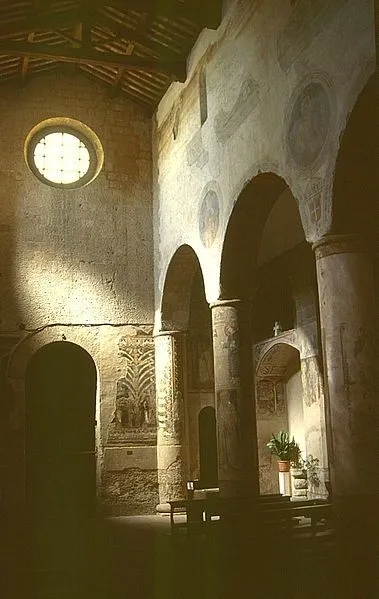
The darkened interior of the oldest church in Orvieto, Italy: Chiesa di San Giovenale
While the town relaxed with aperitif and a glass of wine, I sat across a small table in a kitchen on the top floor of the once-imposing palace. The woman and I look at each other across the stretch of no man’s land littered with the remnants of our dinner. In Italian, she began to explain something she’d only realized in university, once she was far and away from here, the town of her birth.
It was not always such a settled place. Peace didn’t always rule this crest of tufa rock jutting up from the valley below. Before the lamps beat back the darkness with their yellow light, there were torches and candles. Before there were cars to park haphazardly on the cobbles, there were horses. Carriages if you were lucky. A sedan chair from the Seventeenth Century collects dust in the foyer that connects their family apartments.
During the Renaissance and Middle Ages, this place had been a land of mystery and miracles. The Pope himself had dwelt in Orvieto, and after the Miracle of Bolsena, the infamous Duomo di Orvieto was ordered to be constructed. In the modern age, tourists gaze up at the frescoes depicting the descent into hell, and the end of the world. Personally, I’ve always found them fitting, since hell and I are so well acquainted. You could say it reminds me of home.
In the twilight of the Roman Empire, the area was an outpost for the remnants of the Etruscans, who left behind many relics that are still being unearthed in the modern day.
“We were…” she hesitated a moment, searching for the right word to make me understand. I leaned back in my chair, causing its wood to creak beneath my weight.
“..heretical,” she finished. I raised an eyebrow and rested my elbows on the table, perching my chin upon folded hands.
There were once over sixty churches in Orvieto. The Romans notoriously despised the mystery of the natural landscape, but the Etruscans embraced the terrain. This cultural heritage was inherited by the wider Western World, but in Orvieto, in the waning days of Rome and the waxing days of the medieval era, Christianity began to take root. The date it cemented itself? With the destruction of an Etruscan temple to Jupiter, and the rise of the first incarnation of Chiesa di San Giovenale in its place in 1004 AD.
She made deep eye contact with me, in a flash appearing to be sculpted in the fashion of her ancestors before continuing.
“Something I noticed was the location of these parishes, their names, and the attributes the saints took on. Certain names correlate to bodies of water, forests, fires, etc…” she mused.
Christianity was stamped onto the landscape forever, irreversibly changing it in the process.
Stay tuned for a part II!
